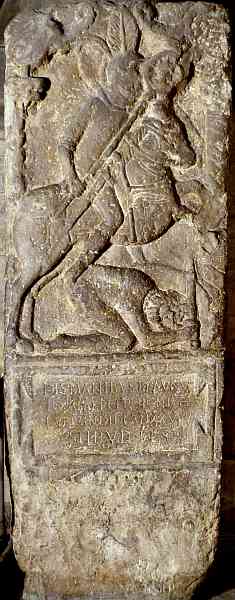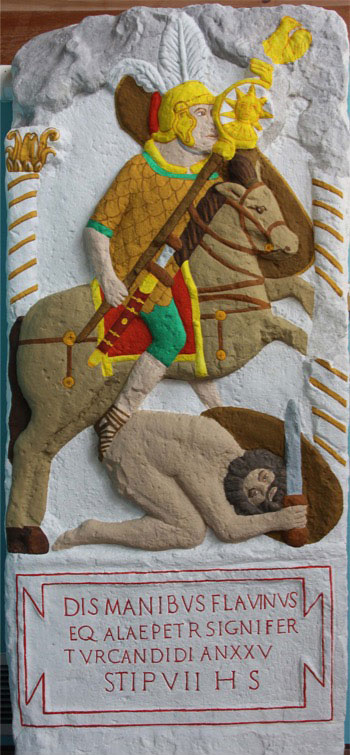Visitor Guide 3: Flavinus Tombstone

The Flavinus Stone is around 2000 years old and is a memorial to a Roman Standard bearer from the troop of Candidus. A reminder of Roman domination in this part of England before Wilfrid arrived. The stone stands at nearly nine feet high and was found in 1881 under part of the floor of the Abbey, the largest example of its kind to have been found in England.

The scene carved on the stone represents a mounted soldier riding over a barbarian. The soldier (Flavinus) is wearing a helmet with a high crest and plume; round his neck is a torque, which indicates his high rank. He is carrying a standard, which displays the sun god in a circle. The barbarian, by contrast, is naked and carries a large oval shield and a short, leaf-shaped sword.
The dedication on the stone reads;
To the Venerated Departed: Here Lies Flavinus
A Horse Rider of the Cavalry Regiment of Petriana
Standard Bearer of the Troop of Candidus
Aged 25, of 7 Years’ Service
According to the inscription, Flavinus was a SIGNIFER or standard-bearer in Candidus’s troop of the ALA PETRIANA. He died at 25, after seven years of military service. Flavinus bore a single Romanised name, rather than a Gaulish one like Asterix or the three names of a Roman citizen. He may have been of some importance in his own country wearing a torque around his neck as a mark of rank among his own Celtic people. Some of his army pay had gone to a regimental burial fund, and helped to provide this impressive tombstone, which probably stood once in the military cemetery near the fort of CORIA (Corbridge); where the Petrian cavalry was based as Rome extended its grip over the Tyne Valley in the years from 79AD.
The ALA PETRIANA, the Petrian Cavalry Regiment, came from Gaul. Gaul had come under Roman rule during the 1st century BC, conquered by disciplined, heavily armed legions of citizen infantry. Once such lands were subdued the Roman army recruited auxiliary regiments from the subject peoples, to serve alongside the legions.
Flavinus’s regiment had a long and distinguished history, but most of it came after the young soldier’s early death. It was nearly doubled in strength to 24 troops or nearly 800 men, becoming a ‘milliary’ ala; its Gaulish warriors were awarded Roman citizenship. It was granted the title ‘Emperor’s own’ (AUGUSTA), and the whole unit was twice decorated for gallantry by the award of the coveted torque, the neck-ring.
